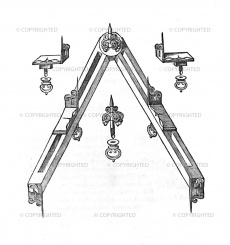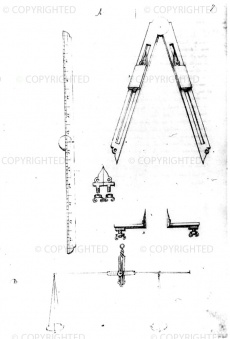"Compasso Magistrale" (Masterly Compasses)
From Inventions
Name documented by Giacomo Contarini around 1590.
Contents |
Inventor
Fabrizio Mordente (1532-1608?)
Historic Period
1554-1584
Description
Compass developed in 1554 by Fabrizio Mordente to measure fractions of a degree with maximum precision in order to perfect the computation of longitude. The first version was designed as a four-point compasses with a ratio of 1:60 between the settings, published by the author in 1567 in a broadsheet printed in Venice with a dedication to D. Barbaro (Modo di trovare con l'Astrolabio… [Method for finding with the Astrolabe…). Between 1568 and 1570 Mordente was in Urbino, where he had Simone Barocci construct a new version of the instrument dedicated to Duke Guidobaldo II della Rovere and called "compasso roverino" (compasses of Della Rovere) in his honour. According to Senator Giacomo Contarini, the instrument was known in Venice as the compasso magistrale and was formed of two flat legs with lengthwise slots, in which slid two cursors with points orthogonal to the legs. In 1572 Mordente was in Vienna, where he presented to Maximilian II the third version of the compass, now at the Adler Planetarium in Chicago. A whole treatise was dedicated to the operations of the new instrument, called "admirabilis circinus", written by the inventor's brother Gasparo and published in Antwerp in 1584: Il compasso del S. Fabrizio Mordente [The compasses of Sig. Fabrizio Mordente]. The following year Mordente went to Paris, where he published the fourth version of the instrument, which took the name of eight-point compasses. Mordente later entered the service of Duke Alessandro Farnese and modified his instrument once more, adding the ninth point and writing a manifesto of sorts announcing the birth of the so-called "residuals science". This last version was described in detail by Michel Coignet, who made it known under the name of nine-point compasses.
Bibliographical Resources
Boffito, Giuseppe. Paolo dell'Abbaco e Fabrizio Mordente. Il primo compasso proporzionale costruito da Fabrizio Mordente e la Operatio Cilindri di Paolo dell'Abaco, Firenze 1931.
Bonelli, Maria Luisa. Di una bellissima edizione di Fabrizio Mordente Salernitano «Mathematico della Sacra Ces.a M.ta dell’Imperatore Rudolfo II», in «Physis», I, 1959, pp. 127-148.
Camerota, Filippo. Il compasso di Fabrizio Mordente: per la storia del compasso di proporzione, Firenze, L.S. Olschki, 2000.
Clavius, Christophorus. Fabrica et usus instrumenti ad horologiorum descriptionem peropportuni, Roma 1586, cap. XXII, p. 120.
Clavius, Christophorus. Geometria Practica, Roma, 1604, I, II, p. 33.
Contarini, Giacomo. Figure d’istromenti matematici e loro uso, ms., 1577-86, Oxford, Bodleian Library, Ms. Canon Ital. 145, cc. 6, 7, 34-35, 41.
Del Monte, Guidobaldo. Meditatiunculae de rebus Mathematicis, Paris, Bibliothèque Nationale, Fonds Latin 10246, cc. 110-111.
Del Monte, Guidobaldo. Lettera a Giacomo Contarini, 6 ottobre 1577, Milano, Biblioteca Ambrosiana, J 231 Infra, cc. 194v-196r.
Mordente, Fabrizio. Modo di trovare con l'Astrolabio, ò Quadrante, ò altro instromento, oltre gradi, intieri, i minuti, et secondi, et ognaltra particella, Venetia 1567.
Mordente, Fabrizio. Il Compasso e Figura di Fabritio Mordente..., Paris 1585.
Mordente, Fabrizio. Problema mirabile di Fabrizio Mordente (1586?), ms., Milano, Biblioteca Ambrosiana, D 235 Inf., cc. 107, 239, Q. 122. Sup., c. 106r.
Mordente, Fabrizio. La Quadratura del Cerchio, la Scienza de' residui, il Compasso et Riga di Fabritio, et di Gasparo Mordente fratelli salernitani, Anversa 1591 (copia manoscritta, Biblioteca Nazionale di Roma, Fondo Gesuitico 615).
Mordente, Fabrizio. Le propositioni di Fabritio Mordente Salernitano…, Roma 1598.
Mordente, Gasparo. Il Compasso del S. Fabritio Mordente con altri Istromenti Mathematici ritrovati da Gasparo suo fratello, Anversa 1584.
Rose, Paul Lawrence. The origins of proportional compass from Mordente to Galileo, in «Physis», X, 1968, pp. 53-69.
Rose, Paul Lawrence. Jacomo Contarini (1536-1595), a venetian patron and collector of mathematical instruments and books, in «Physis», 2, XVIII, 1976, pp. 117-130.
Rosen, Edward. The Invention of the Reduction Compass, in «Physis», X, 1968, pp. 306-308.
Ursi, Nicholaus Raimarus. De Astronomicis Hypothesibus…, Praga 1597, pp. Fii-Fiii.
Existing Instruments
- Adler Planetarium, Chicago
Chicago, Adler Planetarium, inv. M-69
Images
Author of the entry: Filippo Camerota


